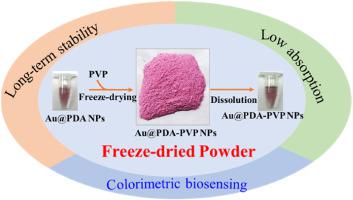Analytica Chimica Acta ( IF 5.7 ) Pub Date : 2022-06-01 , DOI: 10.1016/j.aca.2022.339995 Hongqiang Wang 1 , Xiaofeng Liu 1 , Liyuan Zou 1 , Wenjing Mei 1 , Qingqing Zou 1 , Xiaohai Yang 1 , Qing Wang 1 , Kemin Wang 1

|
Gold nanoparticles (Au NPs) has been widely used to develop label-free colorimetric biosensors. Since the lyophilization process of Au NPs might cause various stresses and lead to irreversible aggregation, Au NPs were usually preserved in an aqueous suspension, which was inconvenienced for transportation and storage. In addition, the potential adsorption interaction between target and Au NPs was often ignored, which may lead to false-signal for Au NPs based colorimetric strategy. Herein, polydopamine-coated gold nanoparticles (Au@PDA NPs) freeze-dried powder was prepared with the assistance of polyvinylpyrrolidone (PVP) (i.e. Au@PDA-PVP NPs) or polyethylene glycol (PEG) (i.e. Au@PDA-PEG NPs). After freeze-dried powder of Au@PDA nanoparticles was redissolved, not only their spectral properties can still be maintained, but also the Au@PDA nanoparticles have nice monodispersity. Besides, the freeze-dried powder has long-term stability and could be stored for at least nine months. Since kanamycin, an aminoglycoside antibiotic, can be absorbed on the surface of Au NPs and induce easily the false signal, it was difficult to be detected using conventional Au NPs-based colorimetric method. Thus, kanamycin was chosen as the model target, a simple, sensitive and label-free colorimetric sensor was established. Given that the adsorption between kanamycin and Au@PDA-PVP NPs was effectively avoided, the possibility of false-positive signal was also reduced. The detection limit of kanamycin was 0.22 nM (S/N = 3), which was met the requirements for the detection of kanamycin residues in milk. This work not only provided an effective and facile way to prepare the nanomaterial lyophilized powder, but also expanded the application of the Au NPs based colorimetric method.
中文翻译:

高稳定性、低吸附的聚合物辅助Au@PDA纳米颗粒冻干粉及其在比色生物传感中的应用
金纳米粒子(Au NPs)已被广泛用于开发无标记比色生物传感器。由于Au NPs的冻干过程可能会引起各种应力并导致不可逆的聚集,因此Au NPs通常保存在水悬浮液中,不方便运输和储存。此外,目标和金纳米粒子之间潜在的吸附相互作用往往被忽略,这可能导致基于金纳米粒子的比色策略出现错误信号。在此,在聚乙烯吡咯烷酮(PVP)(即Au@PDA-PVP NPs)或聚乙二醇(PEG)(即Au@PDA-PEG NPs)的辅助下制备了聚多巴胺包覆的金纳米粒子(Au@PDA NPs)冻干粉。 )。Au@PDA纳米粒子冻干粉重新溶解后,不仅可以保持其光谱特性,而且 Au@PDA 纳米粒子也具有良好的单分散性。此外,冻干粉具有长期稳定性,可保存至少九个月。由于卡那霉素是一种氨基糖苷类抗生素,它可以吸附在金纳米粒子的表面并容易产生错误的信号,因此使用传统的基于金纳米粒子的比色法很难检测到。因此,选择卡那霉素作为模型靶点,建立了一种简单、灵敏、无标记的比色传感器。鉴于有效避免了卡那霉素和Au@PDA-PVP NPs之间的吸附,也降低了假阳性信号的可能性。卡那霉素的检出限为0.22 nM(S/N=3),满足牛奶中卡那霉素残留量的检测要求。











































 京公网安备 11010802027423号
京公网安备 11010802027423号